
How Zeikschrift exposes and reshapes Dutch media
That social media can be used for more than just posting selfies or memes has been proven by media critic and historian Madeleijn van den Nieuwenhuizen, who created her innovative Instagram account Zeikschrift back in July 2016. With Zeikschrift – which roughly translates to ‘whiny writing’ – she denounces Dutch media for using stereotypical, sexist, racist, (hetero)normative, or unjust language and aims at combatting misinformation, harmful framing, and the absence of certain (minority) groups in Dutch journalism.
The creation of Instagram’s Zeikschrift can be traced back to a rather eye-opening experience for van den Nieuwenhuizen. When reading a column published in the Dutch JAN Magazine, she was appalled by the author’s harsh language in describing how they wanted a new "semi-elderly copy from Bulgaria with broken knees’’ as a house cleaner (Vedder, 2018). The condescending tone of the text enraged van den Nieuwenhuizen to such an extent that she expected to find various online messages criticizing the article. When she could not find any, she decided to take matters into her own hands and create her Instagram account Zeikschrift, which would later become a very influential media critical social media account in reshaping Dutch journalistic articles, organizations, and systems.
With Zeikschrift, van den Nieuwenhuizen aims, as stated in her Instagram bio, to "denounce or expose the nonsense in Dutch media, from body shaming to harmful framing.’’ Since 2016, and 459 posts later, the account has gathered over 80.000 followers, of which a number are journalists or work in the industry. Apart from the usual selfie, Zeikschrift mostly shares screenshots of Dutch articles or other media that she believes to be narrow-minded or harmful. With her posts, she emphasizes how normative language structures society without us even noticing. Her ultimate goal is to expose and create dialogues with Dutch media to teach them to be more inclusive and look beyond the normative structures they grew up with.
In this paper, the content on the account Zeikschrift will be analyzed to explore how Madeleijn van den Nieuwenhuizen uses digital vigilantism practices to criticize various Dutch media. Therefore, the research question is as follows: How does Madeleijn van den Nieuwenhuizen use digital vigilantism on her Instagram account 'Zeikschrift' to expose and reshape Dutch media?
Analysing Zeikschrift
To explore the discourse produced on the Instagram account Zeikschrift, three of van den Nieuwenhuizen’s callout posts were analyzed qualitatively by looking at their indexical qualities. Apart from referential meaning, acts of communication produce social or indexical meaning (Blommaert, 2005). An utterance or sign may thus index or point to certain social norms, roles, or identities. Additionally, the concept of intertextuality is used to ground the analyzed discourse into ‘histories of use’ (and abuse). According to Blommaert (2005), intertextuality refers to the fact that "whenever we speak, we produce the words of others. We constantly cite and re-cite expressions, and recycle meanings that are already available.’’
Essentially, this article argues how Madeleijn van den Nieuwenhuizen’s Instagram account Zeikschrift can be interpreted as a case of digital vigilantism. As defined by Trottier (2016), digital vigilantism is "an emerging practice whereby citizen’s use of ubiquitous and domesticated technologies enable a parallel form of criminal justice.’’ It is "a process where citizens are collectively offended by other citizen activity, and coordinate retaliation on mobile devices and social platforms’’ (Trottier, 2016). With the enormous visibility produced through Zeikschrift’s digital vigilantism practices – which include callouts and naming and shaming –, van den Nieuwenhuizen hopes to reshape Dutch media. By making use of social media affordances and denouncing media for using stereotypical, sexist, racist, or unjust language, she aims at creating dialogues with these media (and sometimes even individual reporters) to eventually combat normativity.
Lastly, the concepts framing, selecting and de-selecting articles, and disintermediation are useful in understanding how Madeleijn van den Nieuwenhuizen makes use of Instagram’s affordances to expose and reshape Dutch media. To frame is to "select some aspects of a perceived reality and make them more salient in a communicating text, in such a way as to promote a particular problem definition, causal interpretation, moral evaluation, and/or treatment recommendation for the item described’’ (Entman, 1993). Van den Nieuwenhuizen exposes, among other practices, the unfair framing of Dutch media. Additionally, de-selection refers to "deciding which among articles that have made it through the gates will be taken out of the homepage to be replaced by a new story’’ (Tandoc Jr, 2014). The concept was used to demonstrate how Dutch media incorporate Zeikschrift’s criticism and de-select or edit articles based on this (and the audience’s) criticism. Moreover, disintermediation refers to "the elimination of actors or steps in the chain between creation and dissemination [of information]’’ (Carlson, 2016). This social media affordance lets Zeikschrift bypass journalists and communicate directly to the public. It lessens the gatekeeping role of journalists in deciding what information enters the public sphere.
Zeikschrift’s digital vigilantism
Madeleijn van den Nieuwenhuizen’s Instagram account Zeikschrift can be interpreted as a case of digital vigilantism. As explained before, digital vigilantism is characterized by the use of social media affordances, a "general sense of offense taking,’’ and "moral outrage,’’ (Trottier, 2016). With callout posts on Zeikschrift, Van den Nieuwenhuizen aims at exposing Dutch media for journalistic content that she finds to be unjust, unacceptable, and offensive. Her goal is to teach Dutch media how to be more inclusive and thus to reshape them.
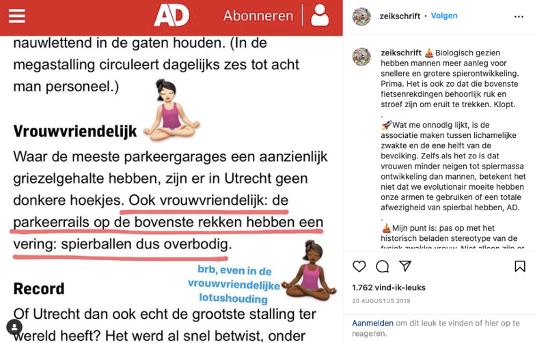
Figure 1. Zeikschrift calling out the Dutch newspaper AD for harmful framing.
In this particular post on Zeikschrift (see Figure 1), Van den Nieuwenhuizen criticizes the Dutch newspaper Algemeen Dagblad (AD) for their normative language use in one of their online articles. When describing a new parking garage built in the Dutch city Utrecht, the author of the article claims the bicycle storage is "female-friendly’’, as it is "not needed to have muscles/ be muscular,’’ to be able to pull the rails of the top racks. This indexes the author thinks women cannot have muscles or be strong. The author has labeled women as the weaker sex and has essentially framed the issue in terms of gender. The author has thus "selected this aspect of a perceived reality and made it more salient in a communicating text’’ (Entman, 1993). Van den Nieuwenhuizen criticizes the author’s gendered framing by saying that "even if it is true that women tend to develop less muscle mass than men, this does not mean we evolutionary have a difficulty using our arms or have a total lack of muscles, AD.’’ In the caption, she emphasizes that the journalist should "beware of using the historically charged stereotype of the physically weak woman.’’ With this, she indexes or points to the harmfulness of categorizing (gender) groups in society and wants to make clear that men do not necessarily have to be strong or muscular and that women do not necessarily have to be weak.
With her post, van den Nieuwenhuizen strongly advises the author – and other Dutch journalists alike – to let go of conditioned thinking and to not categorize gender if it is not necessary. She experienced ‘’a sense of moral outrage’’ when reading AD’s stereotypical article and turned to her Instagram account Zeikschrift to call out the injustice, confront toxic behavior, and ‘’issue calls for action’’ (Trottier, 2016).
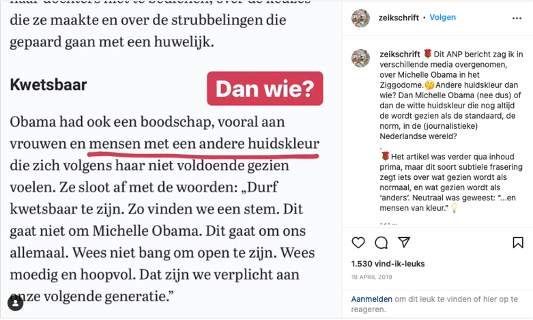
Figure 2. Zeikschrift calling out the Dutch news agency ANP for noninclusive language use.
Similarly, in this other post (see Figure 2), Zeikschrift exposes the Dutch news agency Algemeen Nederlands Persbureau (ANP) for their noninclusive language use in one of their press releases. The author of the press release stated that Michelle Obama had a message for women and "people with a different skin color.’’ Van den Nieuwenhuizen reacted by asking the question: "Other than who?’’, and presumes that the author is "referring to skin colors that are different from the skin color that is still seen as the standard or norm in the Netherlands, namely white.’’ She corrects the author by saying that "people of color would have been a more neutral phrasing.’’ This indexes that she is critical of the noninclusive or ‘othering’ language use – which is intertextual in nature and interconnected to how a number of Dutch people would describe people of color – and aims at teaching and reshaping the Dutch media system to be more inclusive by exposing and calling out toxicity.
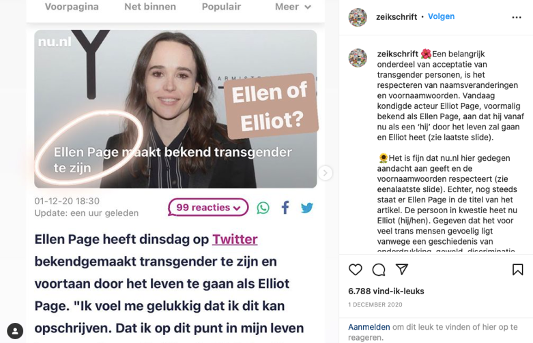
Figure 3. Zeikschrift calling out the Dutch online newspaper NU for deadnaming actor Elliot Page.
Lastly, in this popular post (see Figure 3), van den Nieuwenhuizen criticizes and calls out the Dutch online newspaper Nu.nl for deadnaming the openly transgender Canadian actor Elliot Page. After receiving feedback – that deadnaming is harmful to transgender individuals and should be avoided – from Zeikschrift and other sources, Nu.nl decided to adjust the information in their article and eventually published the correct information. Zeikschrift’s digital vigilantism thus clearly has various positive consequences; by exposing Dutch media, real and needed change is made, eliminating normative thought processes in both audiences and journalistic authors. Social media affordances play a huge part in bringing about these changes and will be discussed in the subsequent section.
Social media affordances
Before social media became the most important communication infrastructure in the Western world, journalists and news agencies were the gatekeepers of the public sphere. Their gatekeeping role meant that they could decide which information entered the public sphere and whose voices would be heard. Nowadays, news selection practices are heavily transformed because of the great impact digital technologies have on everyday practices and daily life. The new role of social media has given audiences a more substantial role in deciding what is newsworthy, important, or sometimes even inappropriate, and Zeikschrift efficiently makes use of Instagram’s affordances to make this known to Dutch media and social media users alike.
One of the social media affordances is disintermediation, which refers to "the elimination of actors or steps in the chain between creation and dissemination [of information]’’ (Carlson, 2016). This affordance lets Zeikschrift (and other sources or social media users) bypass journalists and communicate directly to the public. Zeikschrift is able to enter the public sphere on her own – without journalists’ gates keeping her out – and can contribute to it by posting about the wrongs committed by Dutch media. With that, she reshapes the system, makes it more inclusive, and has a say in how we view social reality, which would not have been possible without social media.
Zeikschrift efficiently makes use of Instagram’s affordances to make this known to Dutch media and social media users alike
As discussed before, van den Nieuwenhuizen’s – and other sources’ – criticism on the Dutch online newspaper Nu.nl brought about real change. After being exposed by Zeikschrift for deadnaming actor Elliot Page (see Figure 3), Nu.nl was encouraged (or felt pressured) to de-select or edit their article after it had already been published. To de-select is to decide "which among articles that have made it through the gates will be taken out of the homepage to be replaced by a new story’’ (Tandoc Jr, 2014). Because of digital affordances, Nu.nl was able to adjust their article and thus take Zeikschrift’s advice and learn from their (inappropriate) language use mistake.
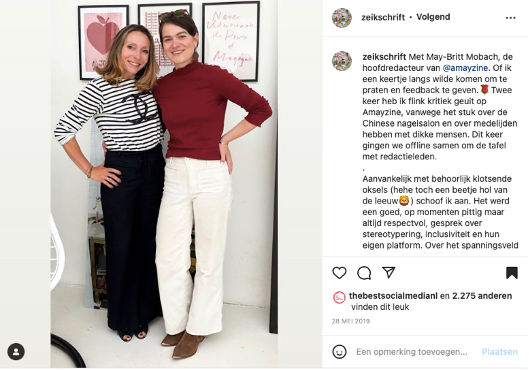
Figure 4. Zeikschrift positively reflecting on a constructive conversation with Amayzine.
On Zeikschrift, multiple other instances can be found of journalists or newspapers de-selecting or editing their articles after van den Nieuwenhuizen had exposed them or called them out. Shortly after posting a screenshot and being critical of a heteronormative article published in the Cosmopolitan, Zeikschrift received a Direct Message (which she posted on her account) from Cosmopolitan’s editor-in-chief saying that "they have edited and adjusted the ‘wrong’ examples,’’ after receiving her feedback and that she should "let them know if something like this happens again.’’ Moreover, Zeikschrift’s critique on one of Glamour’s stereotyping articles was well received by their editor-in-chief and was de-selected immediately. In the caption of the post dedicated to this success, van den Nieuwenhuizen states she "feels proud to see that widely shared critique/ feedback can lead to a smooth and constructive dialogue.’’ Additionally, van den Nieuwenhuizen was invited by the editor-in-chief of beauty magazine Amayzine to "have a constructive talk and give them some feedback’’ after van den Nieuwenhuizen had already heavily criticized the magazine two times. As stated in Zeikschrift’s post (see Figure 4), the conversation was constructive and thus had a positive outcome.
To also keep it light, she commonly posts selfies or chats with her followers. Her content is not always extremely serious, and this is valuable to her followers. With her differing content, Zeikschrift is able to engage an audience that grants her an authoritative role in deciding what is worth discussing. By making use of social media affordances and exposing or calling out Dutch media for their unjust, sexist, racist, or noninclusive language via her Instagram posts, she is able to make a real moral change to how Dutch media deal with language and inclusivity.
Far-reaching effects
However, Zeikschrift’s digital vigilantism can also have negative consequences. In this post, van den Nieuwenhuizen exposes, names and shames, and issues a call for action against Dutch comedian and columnist Youp van ‘t Hek for his extreme sexist language and behavior in an NRC article about his views on the #MeToo movement. In the caption, she states that she "very much applauds all forms of reasonable protest,’’ and that her followers can thus send all the complaint mails they want to NRC’s email address (which she links as well) because her followers "should never think their voices do not matter.’’ With this, she pulls her followers into her digital vigilantism and expresses that she wants them to have a say as well when it comes to reshaping the Dutch media system.
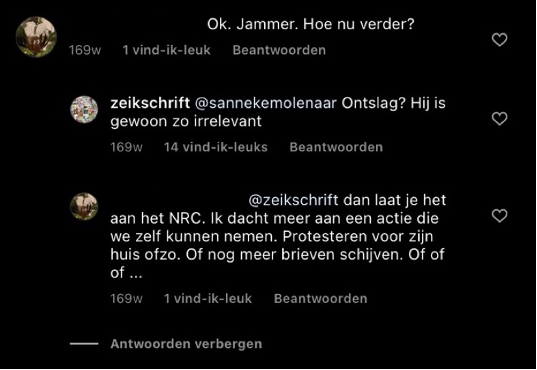
Figure 5. Comments on Zeikschrift’s post, stating more should be done than getting Van ‘t Hek fired.
This in itself cannot be considered a negative consequence of Zeikschrift’s digital vigilantism. However, whereas van den Nieuwenhuizen wants her followers to send complaint mails to get Van ‘t Hek to be fired by NRC for his unjust behavior, her followers take it a step further. Figure 5 shows a comment posted on the aforementioned post. The commenter states that they do not only want Van ‘t Hek to be fired; they want to do more. They want to find out the location of his house and protest in front of it. These actions together "culminate in a mass persecution of a targeted citizen’’ (Trottier, 2016), and even though Van ‘t Hek’s views on women are unjust, we could ask ourselves if this violation of privacy or this harsh punishment is justified.
Zeikschrift and digital vigilantism
Madeleijn van den Nieuwenhuizen, with her Instagram account Zeikschrift, cleverly makes use of digital vigilantism practices like calling out and naming and shaming to expose the wrongdoings of Dutch media and to eventually reshape the whole system.
And she is well underway already, as multiple Dutch media have de-selected or at least edited articles that have received Zeikschrift’s criticism. Social media has become the most important communication infrastructure in the Western world, Zeikschrift is able to enter the public sphere on her own – without journalists’ gates keeping her – and can contribute to it by posting about the wrongs committed by Dutch media. With that, she reshapes the system, makes it more inclusive, and has a say in how we view social reality.
By exposing Dutch media for their unjust, sexist, racist, or noninclusive language via her Instagram posts, she is able to make a real moral change to the Dutch media system. Creating dialogues with these media is her way of combatting normativity and shows she does not only want to expose media but genuinely wants to have constructive conversations with journalists and media on how and why their language use could be more inclusive and appropriate.
Even though Madeleijn van den Nieuwenhuizen’s digital vigilantism has reshaped the Dutch media system into a more inclusive and dialogic system, the practice should still be evaluated critically. Youp van ‘t Hek's persecution is only one example of how digital vigilantism can sometimes go too far in wanting and expecting justice.
References
Blommaert, J. (2005). Discourse: A Critical Introduction. Cambridge University Press.
Carlson, M. (2016). Sources as News Producers. In Witschge et al., The SAGE Handbook of Digital Journalism (1st ed., pp. 236–249). SAGE Publications Ltd.
Entman, R. M. (1993). Framing: Toward clarification of a fractured paradigm. Journal of Communication, 43(4), 51–58.
Tandoc, E. C. (2014). Journalism is twerking? How web analytics is changing the process of gatekeeping. New Media & Society, 16(4), 559–575.
Trottier, D. (2016). Digital vigilantism as weaponisation of visibility. Philosophy & Technology, 30(1), 55–72.
Vedder, E. (2018, October 25). Zeikschrift: hét Instagram-account dat jou op onzin in Nederlandse tijdschriften wijst. Yourdailylife.nl.